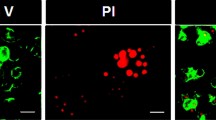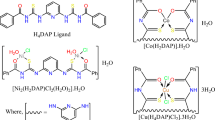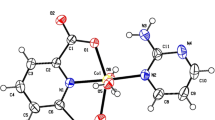Abstract
Norfloxacin is a fluoroquinolone antibiotic used in the treatment of bacterial infections. In this article, we studied the potential antitumoral action of a complex of Norfloxacin with Cu(II), Cu(Nor)2·5H2O on osteosarcoma cells (UMR106) and calvaria-derived cells (MC3T3-E1), evaluating its cytotoxicity and genitoxicity. We have also elucidated the more stable conformation of this complex under physiologic conditions by Molecular Dynamic simulations based on the model of the canonical ensemble and PM6 force field. When solvent effect was taken into account, the complex conformation with both carbonyl groups in opposite sides displayed lower energy. Cu(Nor)2·5H2O caused an inhibitory effect on the proliferation on both cell lines from 300 μM (P < 0.01). Nevertheless, the decline on cell proliferation of UMR106 cells was more pronounced (45 % vs basal) than in MC3T3-E1 cells (20 % vs basal) at 300 μM (P < 0.01). Cu(Nor)2·5H2O altered lysosomal metabolism (Neutral Red assay) in a dose-dependent manner from 300 μM (P < 0.001). Morphological studies showed important transformations that correlated with a decrease in the number of cells in a dose-dependent manner. Moreover, Cu(Nor)2·5H2O caused statistically significant genotoxic effects on both osteoblast cell lines in a lower range of concentrations (Micronucleus assay) (P < 0.05 at 10 μM, P < 0.001 from 25 to 50 μM). UMR106 cells displayed a dose-related genotoxic effect between 5 and 25 μM while the MC3T3-E1 cells showed a narrower concentration dependent range. Altogether, these results suggest that Cu(Nor)2·5H2O is a good candidate to be further evaluated for alternative therapeutics in cancer treatment.





Similar content being viewed by others
References
Padeiskaia EN (2003) Norfloxacin: more than 20 years of clinical use, the results and place among fluoroquinolones in modern chemotherapy for infections. Antibiot Khimioter 48:28–36
Anacona JR, Da Silva GJ (2005) Synthesis and antibacterial activity of cefotaxime metal complexes. J Chil Chem Soc 50:447–450
Williams DR (1971) The metals of life: the solution chemistry of metal ions in biological systems. Van Nostrand-Reinhold, London
Sorenson JRJ (1976) Copper chelates as possible active forms of the antiarthritic agents. J Med Chem 19:135–148
Brown DH, Lewis AE, Smith WE, Teape JW (1980) Antiinflammatory effects of some copper complexes. J Med Chem 23:729–734
Arayne S, Sultana N, Haroon U, Mesaik MA (2009) Synthesis, characterization, antibacterial and anti-inflammatory activities of enoxacin metal complexes. Bioinorg Chem Appl 2009:914105
Pan Q, Kleer CG, van Golen KL, Irani J, Bottema KM, Bias C, De Carvalho M, Mesri EA, Robins DM, Dick RD, Brewer GJ, Merajver SD (2002) Copper deficiency induced by tetrathiomolybdate suppresses tumor growth and angiogenesis. Cancer Res 62:4854–4859
Marzano C, Pellei M, Tisato F, Santini C (2009) Copper complexes as anticancer agents. Anticancer Agents Med Chem 9:185–211
Katsarou ME, Efthimiadou EK, Psomas G, Karaliota A, Vourloumis D (2008) Novel copper(II) complex of N-propyl-Norfloxacin and 1,10-phenanthroline with enhanced antileukemic and DNA nuclease activities. J Med Chem 51:470–478
King DE, Malone R, Lilley SH (2000) New classification and update on the Quinolone antibiotics. Am Fam Physician 61:2741–2748
Turel I, Gruber K, Leban I, Bukovec N (1996) Synthesis, crystal structure, and characterization of three novel compounds of the Quinolone family member (Norfloxacin). J Inorg Biochem 61:197–212
Turel I, Leban I, Zupancic M, Bukovec P, Gruber K (1996) An adduct of magnesium sulfate with a member of the Quinolone family (Ciprofloxacin). Acta Crystallogr C 52:2443–2445
Turel I, Leban I, Klintschar G, Bukovec N, Zalar S (1997) Synthesis, crystal structure, and characterization of two metal-Quinolone compounds. J Inorg Biochem 66:77–82
Chen ZF, Xiong RJ, Zuo JL, Guo Z, You XZ, Fun KH (2000) X-Ray crystal structures of Mg2+ and Ca2+ dimers of the antibacterial drug Norfloxacin. J Chem Soc, Dalton Trans 22:4013–4014
Al-Mustafa J (2002) Magnesium, calcium and barium percholate complexes of ciprofloxacin and Norfloxacin. Acta Chim Slov 49:457–466
Ruiz M, Perello L, Cario JS, Ortiz R, Granda SG, Diaz MR, Canton E (1998) Cinoxacin complexes with divalent metal ions. Spectroscopic characterization. Crystal structure of a new dinuclear Cd(II) complex having two chelate-bridging carboxylate groups.Antibacterial studies. J Inorg Biochem 69:231–239
Ruiz P, Ortiz R, Perello L, Alzuet G, Gonzalez-Alvarez M, Liu-Gonzalez M, Sanz-Ruiz F (2007) Synthesis, structure, and nuclease properties of several binary and ternary complexes of copper(II) with Norfloxacin and 1,10 phenantroline. J Inorg Biochem 101:831–840
Gao F, Yang P, Xie J, Wang H (1995) Synthesis, characterization and antibacterial activity of novel Fe(III), Co(II), and Zn(II) complexes with Norfloxacin. J Inorg Biochem 60:61–67
Sadeek SA, El-Shwiniy WH, Zordok WA, El-Didamony AM (2009) Synthesis, spectroscopic, thermal and biological activity investigation of new Y(III) and Pd(II) Norfloxacin complexes. J Argent Chem Soc 97:128–148
Ibrahim IT, Motaleb MA, Attalah K (2010) Synthesis and biological distribution of Tc-99m–Norfloxacin complex, a novel agent for detecting sites of infection. J Radioanal Nucl Chem 285:431–436
Refat MS (2007) Synthesis and characterization of Norfloxacin-transition metal complexes (group 11, IB): spectroscopic, thermal, kinetic measurements and biological activity. Spectrochim Acta A 68:1393–1405
Jimenez-Garrido N, Perello L, Ortiz R, Alzuet G, Gonzalez- Alvarez M, Canton E, Liu- Gonzalez M, Garcia-Granda S, Perez- Priede M (2005) Antibacterial studies, DNA oxidative cleavage, and crystal structures of Cu(II) and Co(II) complexes with two Quinolone family members, ciprofloxacin, and enoxacin. J Inorg Biochem 99:677–689
Drevensek P, Turel I, Ulrih NP (20039 Influence of copper(II) and magnesium(II) ions on the ciprofloxacin binding to DNA. J Inorg Biochem 96:407–415
Song GW, He Y, Cai ZX (2004) The interaction between levofloxacine hydrochloride and DNA mediated by Cu2+. J Fluoresc 14:705–710
Stewart JJP (2007) Optimization of parameters for semiempirical methods V: modification of NDDO approximations and application to 70 elements. J Mol Model 13:1173–1213
Chongcharoen W, Byrn SR, Sutanthavibul N (2008) Solid state interconversion between anhydrous Norfloxacin and its hydrates. J Pharm Sci 97:473–489
Refat MS (2007) Synthesis and characterization of Norfloxacin-transition metal complexes (group 11, IB): spectroscopic, thermal, kinetic measurements and biological activity. Spectrochimica Acta A 68:1393–1405
Barrio DA, Etcheverry SB (2006) Vanadium and bone development: putative signaling pathways. Can J Physiol Pharmacol 84:677–686
Okajima T, Nakamura K, Zhang H, Ling N, Tanabe T, Yasuda T, Rosenfeld RG (1992) Sensitive colorimetric bioassays for insulin-like growth factor (IGF) stimulation of cell proliferation and glucose consumption: use in studies of IGF analogs. Endocrinology 130:2201–2212
Cortizo AM, Bruzzone L, Molinuevo MS, Etcheverry SB (2000) A possible role of oxidative stress in the vanadiuminduced cytotoxicity in the MC3T3-E1 osteoblast and UMR106 osteosarcoma cell lines. Toxicology 147:89–99
Etcheverry SB, Ferrer EG, Naso L, Barrio DA, Lezama L, Rojo T, Williams PAM (2007) Losartan and its interaction with copper(II): biological effects. Bioorg Med Chem 15:6418–6424
Borenfreund E, Puerner JA (1984) A simple quantitative procedure using monolayer culture for toxicity assays. J Tissue Cult Methods 9:7–9
Fenech M (2000) The in vitro micronucleus technique. Mutat Res 455:81–95
Stopper H, Muller SO (1997) Micronuclei as a biological endpoint for genotoxicity: a minireview. Toxicol In Vitro 11:661–667
Castillo-Blum SE, Barba-Behrens N (2000) Coordination chemistry of some biologically active ligands. Coord Chem Rev 196:3–30
Turel I (2002) The interaction of metal ions with Quinolone antibacterial agents. Coord Chem Rev 232:27–47
Macías B, Villa MV, Rubio I, Castiñeiras A, Borrás J (2001) Complexes of Ni(II) and Cu(II) with Nofloxacin. Crystal structure of a new Cu(II) Nofloxacin complex. J Inorg Biochem 84:163–170
Lee C, Yang W, Parr RG (1988) Development of the Colle-Salvetti correlation-energy formula into a functional of the electron density. Phys Rev B 37:785–789
Becke AD (1993) Density-functional thermochemistry. III. The role of exact exchange. J Chem Phys 98:5648–5652
Wang X (2010) Fresh platinum complexes with promising antitumor activity. Anticancer Agents Med Chem 10:396–411
Frezza M, Hindo S, Chen D, Davenport A, Schmitt S, Tomco D, Dou QP (2010) Novel metals and metal complexes as platforms for cancer therapy. Curr Pharm Des 16:1813–1825
Tardito S, Marchio L (2009) Copper compounds in anticancer strategies. Curr Med Chem 16:1325–1348
Tisato F, Marzano C, Porchia M, Pellei M, Santini C (2010) Copper in diseases and treatments, and copper-based anticancer strategies. Med Res Rev 30:708–749
Harris AL, Hochhauser D (1992) Mechanisms of multidrug resistance in cancer treatment. Acta Oncol 31:205–213
Shingnapurkar D, Butcher R, Afrasiabi Z, Sinn E, Ahmed F, Sarkar F, Padhy S (2007) Neutral dimeric copper–sparfloxacin conjugate having butterfly motif with antiproliferative effects against hormone independent BT20 breast cancer cell line. Inorg Chem Commun 10:459–462
Repetto G, del Peso A, Zurita JL (2008) Neutral red uptake assay for the estimation of cell viability/cytotoxicity. Nat Protoc 3:1125–1131
Ivanova L, Uhlig S (2008) A bioassay for the simultaneous measurement of metabolic activity, membrane integrity, and lysosomal activity in cell cultures. Anal Biochem 379:16–19
Buchtik R, Travnicek Z, Vanco J, Herchel R, Dvorak Z (2011) Synthesis, characterization, DNA interaction and cleavage, and in vitro cytotoxicity of copper(II) mixed-ligand complexes with 2-phenyl-3-hydroxy-4(1H)-quinolinone. Dalton Trans 40:9404–9412
OECD Guideline http://www.oecd.org/document/35/0,3746,en_2649_34377_45773411_1_1_1_1,00.html
Coughlin SA, Danz DW, Robinson RG, Klingbeil KM, Wentland MP, Corbett TH, Waud WR, Zwelling LA, Altschuler E, Bales E, Rake JB (1995) Mechanism of action and antitumor activity of (S)-10-(2,6-dimethyl-4-pyridinyl)-9-fluoro-3-methyl-7-oxo-2,3-dihydro-7Hpyridol[1,2,3-de] [1,4] benzothiazine -6-carboxylic acid. Biochem Pharm 50:111–122
Clement JJ, Burres N, Jarvis K, Chu DT, Swiniarski J, Alder J (1995) Biological characterization of a novel antitumor Quinolone. Cancer Res 55:830–835
da Silveira VC, Benezra H, Luz JS, Georg RC, Oliveira CC, Ferreira AM (2011) Binding of oxindole-Schiff base copper(II) complexes to DNA and its modulation by the ligand. J Inorg Biochem 105:1692–1703
Lee WY, Yan YK, Lee PP, Tan SJ, Lim KH (2012) DNA binding and nucleolytic properties of Cu(II) complexes of salicylaldehyde semicarbazones. Metallomics 4:188–196
Acknowledgments
This work was partly supported by UNLP (11X/554), CONICET (PIP 1125), ANPCyT (PICT 2218 and PICT-2010-0981). The authors would like to thank MINCYT (CO/08/07) from Argentina, and UdeA and COLCIENCIAS from Colombia, for mobility funding. ALDV and SBE are members of the Carrera del Investigador, CONICET, Argentina. IEL is a fellowship from ANPCyT, Argentina.
Author information
Authors and Affiliations
Corresponding author
Rights and permissions
About this article
Cite this article
Di Virgilio, A.L., León, I.E., Franca, C.A. et al. Cu(Nor)2·5H2O, a complex of Cu(II) with Norfloxacin: theoretic approach and biological studies. Cytotoxicity and genotoxicity in cell cultures. Mol Cell Biochem 376, 53–61 (2013). https://doi.org/10.1007/s11010-012-1548-8
Received:
Accepted:
Published:
Issue Date:
DOI: https://doi.org/10.1007/s11010-012-1548-8




